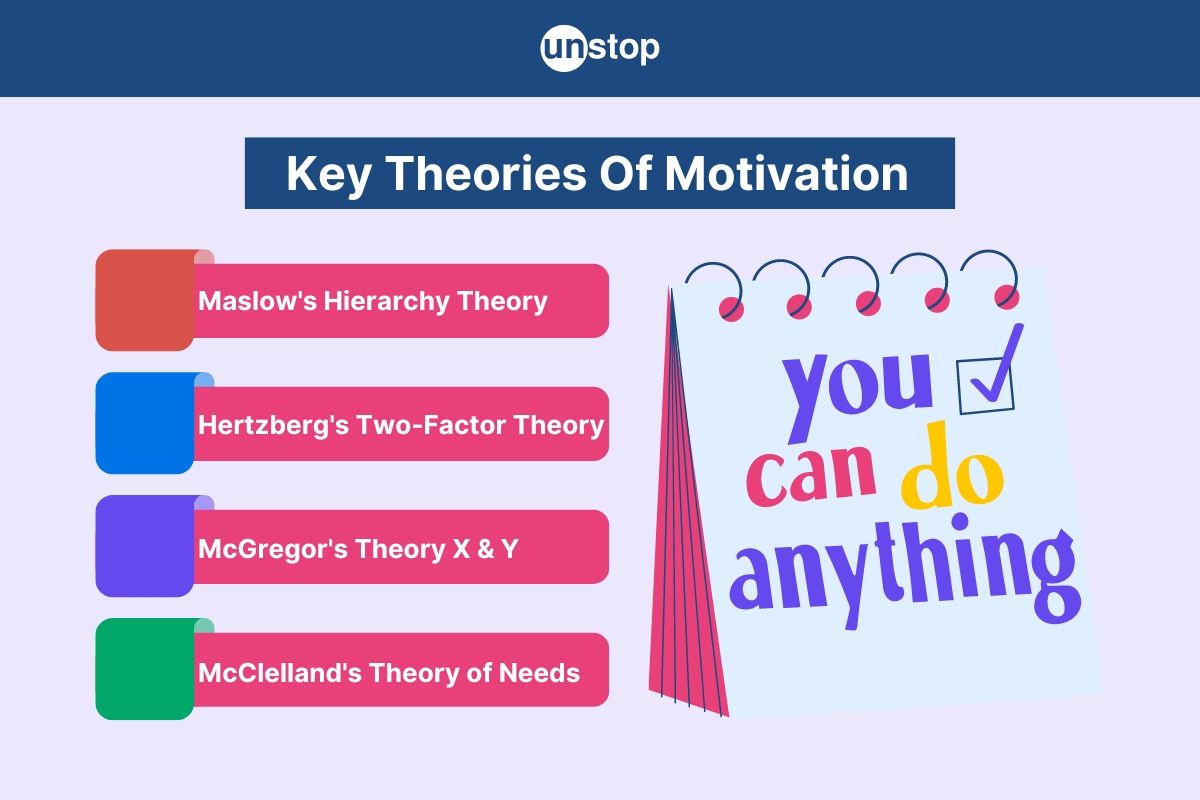- What Is The Theory Of Motivation?
- Exploring Key Theories Of Motivation
- Diving Into Specific Motivation Types
- Theory Of Motivation In Real-Life Scenario
- Integrating Various Motivation Concepts
- Conclusion
- Frequently Asked Questions
Theory Of Motivation | Key Theories, Concepts And Applications

The theory of motivation explores the underlying factors that drive individuals to take action, sustain effort, and achieve their goals. We can gain insights into the diverse motivators that influence human behaviour by examining psychological frameworks such as Maslow's Hierarchy of Needs, Herzberg's Two-Factor Theory, and Vroom's Expectancy Theory.
Whether you're a student aiming for better grades or a professional seeking career growth, grasping these concepts can make a big difference. Explore essential aspects of motivation theory and discover practical tips you can immediately apply.
What Is The Theory Of Motivation?
The theory of motivation encompasses various psychological frameworks that explain what drives individuals to initiate, sustain, and achieve their goals. These theories seek to understand the underlying mechanisms and factors that influence human behaviour, such as needs, desires, goals, and external incentives.

Individuals' actions and behaviors are driven by motivation, which affects how they choose their goals, how hard they work towards them, and how long they stick with their efforts.
It encompasses both intrinsic factors, such as personal growth, satisfaction, and enjoyment, and extrinsic factors, like rewards, recognition, and external incentives.
Exploring Key Theories Of Motivation
Let us explore some of the prominent theories of motivation:
Maslow's Hierarchy
In 1943, Maslow introduced his hierarchy of needs, which consists of five levels: physiological, safety, love/belonging, esteem, and self-actualization. Each level must be met before moving to the next.
Employees need basic needs met first, like salary and job security. Self-actualization involves achieving personal goals and potential.
Hertzberg's Two-Factor Theory
Hertzberg introduced the two-factor theory in 1959. It separates factors into hygiene and motivators. Hygiene factors include salary, company policies, and working conditions. They prevent dissatisfaction but do not motivate.
Motivators include recognition, responsibility, and personal growth. They lead to higher satisfaction and motivation in the workplace.
McGregor's Theory X And Theory Y
In the 1960s, McGregor introduced Theory X and Theory Y. According to Theory X, workers are lazy and require close monitoring. Managers who adopt this approach tend to micromanage their employees.
Theory Y assumes employees are self-motivated and enjoy work. This approach encourages participation and creativity. Theory Y leads to better productivity and job satisfaction.
McClelland's Theory of Needs
David McClelland identified three key needs that drive human motivation:
Need for Achievement (nAch): The desire to excel, achieve in relation to a set of standards, and strive for success.
Need for Affiliation (nAff): The longing to build friendly and close relationships with others.
Need for Power (nPow): The desire to influence, control, and be responsible for others.
McClelland's theory is often used to understand workplace behaviour and tailor motivational strategies to individual needs.
Vroom's Expectancy Theory
Victor Vroom suggested that motivation depends on three combined factors:
Expectancy: The conviction that putting in effort will achieve the desired performance.
Instrumentality: The assurance that good performance will be compensated.
Valence: The significance an individual assigns to the rewards.
Vroom's theory emphasizes the importance of clear expectations, attainable goals, and meaningful rewards in motivating individuals.
Self-Determination Theory (SDT)
Edward Deci and Richard Ryan introduced SDT, which focuses on three intrinsic needs that foster motivation and well-being:
Autonomy: The need to feel in control of one's own behaviour and goals.
Competence: The need to gain mastery and effectiveness in tasks.
Relatedness: The need to feel connected to others.
SDT suggests that environments supporting these needs enhance intrinsic motivation, well-being, and engagement.
Goal-Setting Theory
Edwin Locke and Gary Latham suggested that having clear, difficult goals can boost performance:
Clarity: Clear and specific goals.
Challenge: Goals should be difficult yet attainable.
Commitment: The individual must be committed to the goal.
Feedback: Regular feedback on progress.
Task Complexity: Consideration of the complexity of the task and the necessary time and resources.
Goal-setting theory highlights the motivational power of well-defined and challenging goals supported by feedback and commitment.
Equity Theory
John Stacey Adams proposed that individuals are motivated by fairness in the workplace. They compare their input-output ratios with those of others:
Inputs: What they bring to the job (effort, skill, experience).
Outputs: What they receive (salary, benefits, recognition).
Equity theory emphasizes the importance of perceived fairness in motivation. When individuals perceive inequity, they are motivated to restore balance.
Diving Into Specific Motivation Types
Let us specifically dive into some of the motivation types:
Achievement
In McClelland's Theory of Needs, achievement motivation is key. People motivated by achievement aim to excel and meet high standards.
They set tough goals and take calculated risks. These individuals often like working alone or with other high achievers. Their actions are driven by a need for personal success.
Affiliation
Affiliation motivation focuses on the need for friendly relationships. Individuals motivated by affiliation thrive in cooperative environments. They value social interactions and group activities.
This drive influences their behaviour to seek approval and avoid conflict. Such people are effective in team settings where harmony is essential.
Power
Power motivation involves the desire to influence others. There are two types: personal power and institutional power.
Personal power seekers want to control others, while institutional power seekers aim to organize efforts for group objectives. This motivation type affects behaviour by driving people to leadership positions.
Expectancy
Vroom's Expectancy Theory has three parts: expectancy, instrumentality, and valence. Expectancy means believing that effort will improve performance.
Instrumentality is the belief that doing well will lead to rewards. Valence is how much those rewards matter to a person. These elements together determine a person's motivation to take action.
Instrumentality
Instrumentality connects performance and outcome. If individuals believe their performance will lead to rewards, they are more likely to be motivated.
For example, employees work harder if they trust that their efforts will result in promotions or bonuses.
Valence
Valence refers to the importance of expected rewards. Different people value different rewards based on their needs and desires. High valence means a reward is highly valued, thus increasing motivation.
Theory Of Motivation In Real-Life Scenario
Let us study some of the applications of the theory of motivation in real-life scenarios:
Application Of Maslow Hierarchy
Businesses can use Maslow's hierarchy to enhance employee engagement. They should first ensure that basic needs like salary and safe working conditions are met. This forms the foundation for higher-level needs.
Companies can enhance social needs by organizing team-building events to create a sense of belonging. Recognition programs can meet esteem needs by making employees feel appreciated. Providing growth and career advancement opportunities can satisfy self-actualization needs.
Application Of Hertzberg's Two-Factor Theory
Hertzberg's two-factor theory divides workplace factors into hygiene and motivators. To boost morale, businesses should first address hygiene factors, such as company policies and work conditions.
Improving these factors reduces dissatisfaction. Then, focus on motivators such as recognition, responsibility, and personal growth. Providing meaningful work increases job satisfaction and reduces turnover rates.
Application Of McClelland Theory
McClelland's Theory emphasizes recognizing individual motivational drivers. Leaders should identify if team members are driven by achievement, affiliation, or power.
For achievement-driven employees, set challenging goals and provide feedback. For those motivated by affiliation, create a collaborative environment. Power-driven individuals thrive with leadership opportunities and decision-making roles.
By understanding these drivers, leaders can tailor their approach to each team member. This results in higher productivity and better job satisfaction.
Integrating Various Motivation Concepts
Let us also study the importance of integrating various motivation concepts:
Holistic Approach
A holistic approach to motivation combines multiple theories. This ensures comprehensive workforce management. Motivational processes are complex and diverse. Using just one theory may not address all needs.
Managers should understand various motivational mechanisms. Cognitive motivation focuses on mental processes. Instinct motivation theory highlights innate drives. Combining these can offer a fuller picture of human motivation.
Intrinsic & Extrinsic Strategies
Combining intrinsic and extrinsic strategies benefits employees. Intrinsic motivation comes from within. It includes personal satisfaction and growth. Extrinsic motivation involves external rewards like money or praise.
Balancing both types is key. Employees need internal fulfilment and external recognition. This mix can improve overall motivation levels.
Assessing Relevant Theories
Managers must assess which theories fit their organization. Factors include organizational culture, goals, and team composition. Rational motivation works well in logical, data-driven environments. Behaviour motivation might suit action-oriented teams.
Conclusion
You've now got a solid grasp of core motivation theories and how they apply to different areas of life. By understanding specific types of motivation, you can better drive your goals and inspire others around you. Integrating these concepts helps you create a more motivated and productive environment, whether at work, school, or home.
Understanding motivation theories helps create environments that boost motivation, performance, and well-being. By considering various motivational factors, companies can tailor strategies to meet employees' needs, leading to higher engagement and productivity.
Frequently Asked Questions
1. What are the core theories of motivation?
The core theories include Maslow's Hierarchy of Needs, Herzberg's Two-Factor Theory, and McClelland's Theory of Needs. Each explains different aspects of what drives people.
2. How can I apply motivation theories in my daily life?
Identify your goals and understand what motivates you. Use this knowledge to set achievable targets and reward yourself for progress.
3. What is intrinsic motivation?
Intrinsic motivation comes from within. It involves doing activities because they are inherently enjoyable or fulfilling, not for external rewards.
4. Can understanding motivation theories improve workplace productivity?
Yes, understanding these theories helps managers create environments that boost employee morale, leading to higher productivity and job satisfaction.
5. Why is it important to integrate various motivation concepts?
Integrating different concepts provides a comprehensive understanding of what drives behaviour, allowing for more effective strategies in personal and professional settings.
Suggested reads:
Instinctively, I fall for nature, music, humor, reading, writing, listening, traveling, observing, learning, unlearning, friendship, exercise, etc., all these from the cradle to the grave- that's ME! It's my irrefutable belief in the uniqueness of all. I'll vehemently defend your right to be your best while I expect the same from you!
Login to continue reading
And access exclusive content, personalized recommendations, and career-boosting opportunities.
Subscribe
to our newsletter
















Comments
Add comment